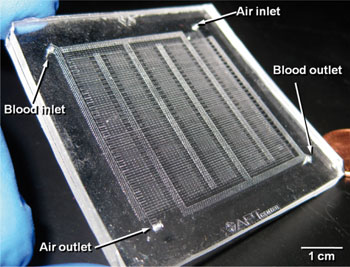US scientists have mimicked the structure of a lung to make a device that can use air as a ventilating gas instead of pure oxygen. The invention could mean that oxygen cylinders to accompany artificial lung devices for lung disease patients are a thing of the past and implantable devices could be a step closer.
Joseph Potkay from Louis Stokes Cleveland VA Medical Centre and co-workers fashioned microfluidic channels from the polymer polydimethylsiloxane and made them branch into smaller channels and then into artificial capillaries, similar to the arteries and capillaries in a real lung. The oxygen exchange efficiency is three to five times better than current artificial lung devices owing to the small, micron-scale, blood and air channels.
At the moment, lung disease patients in need of respiratory support rely on mechanical ventilators in which blood from the patient is circulated through a machine to oxygenate it. As Jeffrey Borenstein, an expert in microsystems technology and biomedical devices at the Charles Stark Draper Laboratory, US, points out: ‘Current technology involves complex systems that are limited to intensive care units, so Potkay’s device has the potential to provide clinically relevant oxygenation levels using ambient air, opening the door to portable systems.’
The team aims to improve their device’s blood compatibility and scale it up so it can deliver enough oxygen to be suitable for humans.
Interested? Read Holly Sheahan‘s full Chemistry World article here or download the Lab on a Chip paper:
Bio-inspired, efficient, artificial lung employing air as the ventilating gas
Joseph A. Potkay, Michael Magnetta, Abigail Vinson and Brian Cmolik
Lab Chip, 2011, Advance Article
DOI: 10.1039/C1LC20020H











